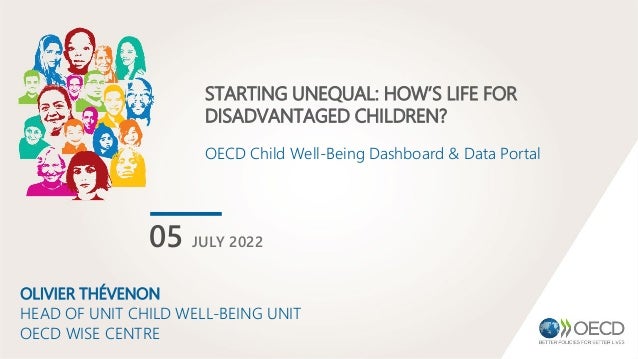
Steering child well-being policies with good data - OECD
- 1. STARTING UNEQUAL: HOW’S LIFE FOR DISADVANTAGED CHILDREN? OECD Child Well-Being Dashboard & Data Portal 05 JULY 2022 OLIVIER THÉVENON HEAD OF UNIT CHILD WELL-BEING UNIT OECD WISE CENTRE
- 2. © OECD | OECD Work on Measuring Child Well-being 2
- 3. © OECD | The OECD Child Well-being Measurement Framework Is multi-dimensional Is age- & stage-sensitive Reflects children’s lives today and tomorrow Reflects children’s views Captures children’s environments Covers public policies
- 4. © OECD | The revised OECD Child Well-being Data Portal https://oe.cd/cwb-data • Structured around: The OECD Child Well-being Measurement Framework • Measures: 200+ • Country coverage (where available): OECD Members and Partners, OECD Accession Countries, non-OECD G20, non-OECD EU Member States • Breakdowns by (where available): Age; Sex; Family type; Migrant background; Language spoken at home; Parents’ education; Household employment status; Income/Socio-economic status; Urbanisation • Sources: PISA, HBSC, TIMSS/PIRLS, + OECD Databases and other international datasets
- 5. © OECD | The new OECD Child Well-being Dashboard https://oe.cd/cwb-dashboard • Structured around: The OECD Child Well-being Measurement Framework • Indicators: 20 key outcome indicators • Source: OECD Child Well-being Data Portal • Functions: - Monitoring tool: Accessible information for policy-makers on (comparative) performance on child well-being - Communications tool: User-friendly information on children and child well-being for a broader audience
- 6. © OECD | Starting Unequal: childhood disadvantage stretches across all dimensions of well-being (1/2) children from disadvantaged backgrounds are more likely to : • experience poor material outcomes, including a lack a basic food and nutrition, a lack of good-quality housing, and a lack of access to modern necessities, like the internet. • experience poor health outcomes, with those with low socio-economic status over- represented among overweight and obese children and those reporting poorer self-rated health. • do worse in education: On average across OECD countries, only 6% of disadvantaged 15-year-olds reached “top performer” status on the OECD PISA tests, compared to 29% among the most advantaged. They are also far more likely to report limited ambitions for future education. • report poorer social and emotional outcomes, including weaker perceived support from family, lower self-belief, and lower life satisfaction. Clarke, C. and O. Thévenon (2022), "Starting unequal: How’s life for disadvantaged children?", OECD Papers on Well-being and Inequalities, No. 06, OECD Publishing, Paris, https://doi.org/10.1787/a0ec330c-en.
- 7. © OECD | Disadvantaged children face poorer environments at home, in school, and in the community • At home, disadvantaged children are often more likely to miss out on important family activities and experience poorer quality relationships with parents. on average across OECD countries, 36% of disadvantaged 11 , 13 and 15 year-olds report finding it difficult to talk to their parents, compared to 28% among the most advantaged. • At school, disadvantaged children frequently experience poorer quality learning environments, are more likely to experience bullying, and more often report a lack of connectedness to their school and others. On average across OECD countries, only two thirds of 15 year olds from disadvantaged backgrounds report feeling like they belong at school, compared to three quarters among the most advantaged. • With peers, disadvantaged children more frequently feel like they do not have enough friends, and more often report poorer support from friends. On average across European OECD countries, 12% of low income children live in areas with problems with crime and violence – more than 50% higher than the rate for high income children.
- 8. © OECD | Future directions for the child well-being data work Improving the quality of child data, including on material well-being, family living arrangements, households’ expenditures on children, parental time and children’s time use (including online). •Informal working group with NSO’s contact points Child-friendly neighbourhoods • Data development on the quality of children’s neighbourhood, including on children’s access (and gaps in access) selected essential services (e.g. health, care and education services, leisure facilities, etc.), to green areas, and exposure to certain risks for their physical and/or their emotional or social well-being (exposure to pollution, violence and crime, unsafe traffic, etc.). Children of the digital world Develop measures of children’s digital well-being and practices, their digital learning, and their perceptions of the benefits and risks attached to the online world
- 9. © OECD | Contact us: Chris.Clarke@oecd.org Olivier.Thevenon@oecd.org Visit the OECD Child Well-being Dashboard: https://oe.cd/cwb-dashboard Learn about the OECD WISE Centre: https://www.oecd.org/wise Measuring What Matters for Child Well-being and Policies https://doi.org/10.1787/a0ec330c-en